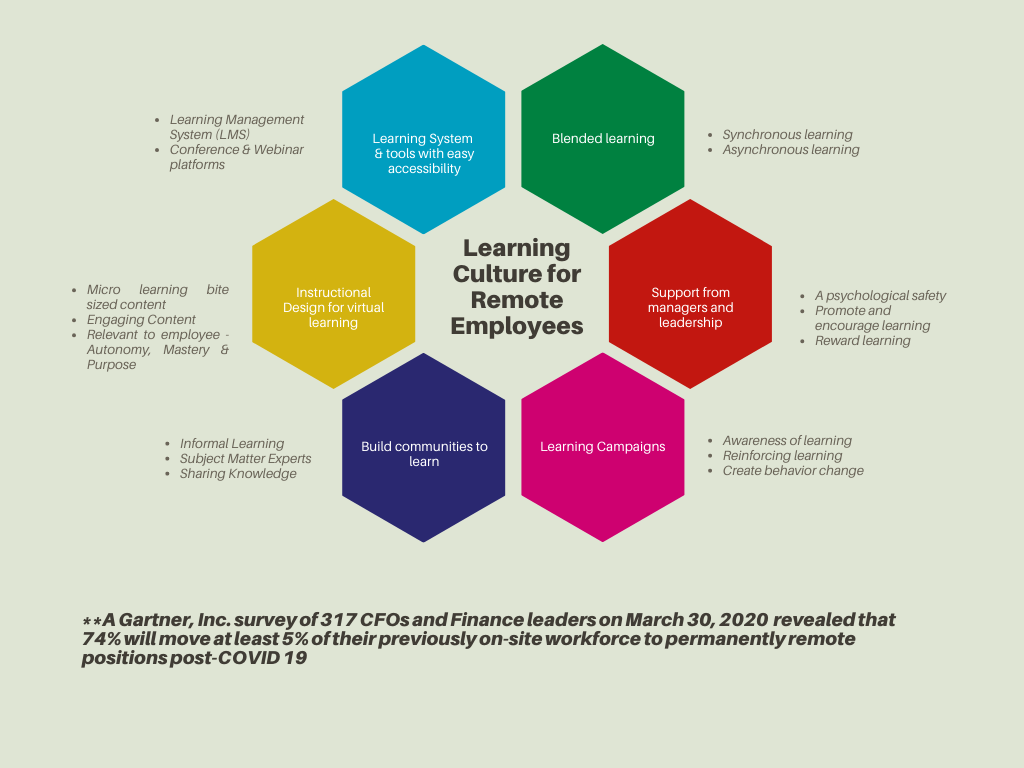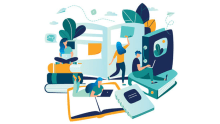How to build a learning culture for remote employees

Learning forms an integral part of the growth of any organization to sustain in the industry. Building a culture that encourages, supports and empowers learning in the organization is like a lifeline to adapt to the ever-changing business environment. Corporate Executive Board (CEB), a subsidiary of Gartner, defines Learning Culture as “a culture that supports an open mindset, an independent quest for knowledge, and shared learning directed toward the mission and goals of the organization”. Adaptive and learning organizations continuously prepare themselves for future skills and emerging technologies for quality performance. Post COVID-19, learning has undergone a paradigm shift due to transformation in the workforce and business. Most of the employees are working remotely which requires Learning and Development (L & D) function to change its strategies to ensure remote learning for all and sustain leaning culture too. In-person learning sessions may not be possible or will be limited for quite some time for employee safety; and no organization would like to create that skill void and deprive its employees of learning opportunities as the cost may be really high for such ignorance. Virtual learning is the solution to train remote employees and keep the ball rolling for building capabilities of employees. The quick demand to design courses and content in digital learning format which is engaging, relevant, precise, and easily accessible for remote employees has put L&D function on the toes every since this pandemic started. The challenge for L&D is to instill learning culture in employees even when they are working remotely.
How can we ensure training or develop a learning culture for remote employees in a virtual learning environment

Blended Learning: One size might not fit all when it comes to remote learning as each employee is in a different state of mind, work, and physical situation due to this pandemic, therefore, require flexibility to learn. Organizations are focusing on creating a blend of synchronous and asynchronous learning to create a better-customized learning experience for its workforce. Synchronous learning is scheduled training with multiple learners at the same time. For e.g, it may be an instructor-led virtual classroom session in a particular time slot for training the sales team on making a sales pitch to customers via online modes. Asynchronous learning is a self-paced training where employees have the liberty to choose their own time to access course content, assessment, and course completion status within given timelines without effecting their work deliverables. For e.g. it may be E-learning or video-based learning on compliance through LMS or other digital platforms which may have support in form of online Q& A. A blended/ collaborative approach is a better solution in this remote learning environment which facilitates to create a good learning experience (LX) for its employees.
Learning system & tools with easy accessibility: Technology plays a game changer role in the delivery of virtual or remote learning as it can reach remote employees via learning systems and platforms only. If a company has a Learning Management System in place, a proper centralized content library is a must with a user-friendly interface and accessibility from any device at any time to support job performance.LMS may also automate the administrative process of inviting attendees, links to webinars/podcasts, assigning courses, and tracking outcomes. Conferencing and webinar platforms like Zoom, WebEx, Microsoft Teams, Google Meetings, etc. can be chosen depending upon the learning objective, target audience, and no of attendees for seamless training delivery. If required there can be E-learning or video training for employees on how to use these conference platforms or LMS to start with. Also, the resources and links of scheduled or self-paced training should be available anytime, anywhere and any device like mobile, laptop, or desktop as the flexibility of learning is critical at this stage when employees are struggling to have work-life integration.
Instructional Design for virtual learning: The content and personal interaction that worked wonders in classroom training may not have the same effect in a virtual classroom .L&D is mindful of the fact that they need to redesign their learning interventions for remote employees to align individual and business learning goals. It would be a good idea to conduct a virtual survey or poll to ask what employee’s learning needs are? How they solve work problems? How they find help to resolve work-related problems? What their digital delivery preferences are? It is important to identify what triggers them to access information.
- The existing content/course/programs can be updated to make training more meaningful as a performance support tool.
- Learning in the flow of work by dividing the training into bite-sized also called microlearning to make it easy for employees to learn during work.
- The delivery method should be carefully selected based on experience, different skills, tech comfort, and age group of employees. For e.g, Social media platforms might appeal more to Gen Z than Gen X.
- Allocate training as per the current knowledge and expertise of the employee through the virtual assessment of competency level. Anyone with basic knowledge can hop on to advanced levels and still have access to fundamental content if required. Any training should add value to the existing performance level.
- Relevance to employees: Three pillars of Adult learning - Autonomy, Mastery & Purpose should be the focus of virtual learning too. Upskilling, reskilling, and cross-functional skilling for career growth is the survival strategy in this pandemic and uncertain future ahead.
- With isolation due to pandemic, employees would prefer to have more engaged learning with social/personal touch. Content with visual appeal and light on the text in form of info graphics, slides, videos, animations, chat boxes, breakout sessions and many more ,may facilitate productive learning with interesting features. Engagement and knowledge in a remote session can be tested via polls, assessment, quiz, gamification etc.
Build communities to learn: Encourage virtual groups, teams, or communities where internal Subject Matter Experts from within the organization can impart informal leaning in form of videos, posts, tips, counselling sessions to desired learners. Sharing knowledge is an important aspect of learning culture. Learning from peers will get more engagement and encouragement for employees to collaborate as they are part of the same organization and understand the business at the same frequency.
Learning Campaigns: L&D function can create campaigns for employees by marketing why learning is important even when working remotely. Why it is important to fill the skills gaps to improve the quality of performance? In order to deal with the friction or conflict where employees might prioritize work over learning in this pandemic crisis, L&D should emphasize the rationale behind learning even more for career advancement in these uncertain times. This is for awareness, reinforced messages, and creating behavioural changes for developing learning habits. Also, a repetitive teaser email notification or videos for training highlighting the relevance, urgency, content, potential benefits, desired outcomes, as performance support with links to LMS bite-sized content and online programs can be done to gain traction of learners. This reinforcement through different channels can motivate employees to come back to learning platforms time and again and achieve behavioural changes. Similarly, informal virtual sessions or surveys to discuss learning needs, preferred delivery methods, ideas for content, and feedback on existing programs can be facilitated to improve learning every day.
Support from managers and leadership: Learning is not just the sole responsibility of L & D function; it’s a collaborative approach that requires the support of employees, managers, and leaders to build a learning culture. Leadership has a larger responsibility to encourage or promote learning opportunities for better performance showing empathy at the same time considering the current situation of employees. A psychological safety from leadership in form of openness to consider new ideas for experimentation, ask questions, take risks, and create learning moments of success or failure is what will push employees to value training. A leader can be like a mentor who provides constructive feedback and propel desire to have self-learning goals aligned with business goals. Embrace individuals and teams which reflect a growth mindset by spotlighting them on social platforms or internal communication. Motivate employees by rewarding digitally with certification on completion of a course.
Nurturing a learning culture for remote employees is certainly challenging but not impossible. A well laid out learning strategy with the support of leadership, right methodology and technology can help to sustain a continuous learning culture in this virtual learning environment. Creating a personalized, blended, engaged and well-facilitated learning can elevate the Learning Experience of remote employees and motivate them to come back to LMS or learning platforms repetitively as a performance support tool. Organizations that have a growth mindset and invest in building leaning culture are the ones who will be creating a future-ready remote workforce for the new normal.
Do let us know if your organization has gone an extra mile to ensure learning in spite of this virtual environment...We’ll be glad to hear innovative initiatives by your organizations to keep learning culture intact even in this pandemic.
Join us at People Matters L&D SEA Conference 2021 coming to your screens on 4rth March 2021. Click here to register.












